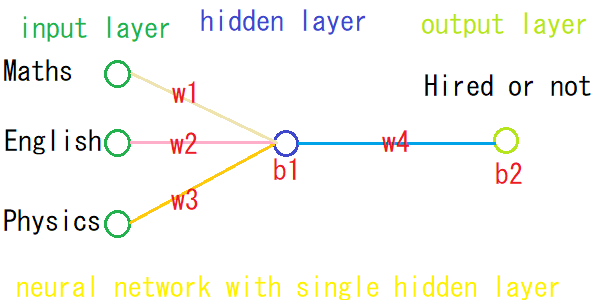概要
今回は1つの隠れ層を入れてネットワークを構築します。前回のベースにプログラムを書いているので、もし読んでいない場合は、まずニューラルネットワークの基礎知識 - 1を読むことをお勧めします。
ネットワークを構成
今回作成するネットワークは、入力層で3つのニューロン(ノード)を持ち、隠れ層で1つのニューロン、そして出力層でも1つのニューロンを持ちます。
Let's Code
# numpyのインポート
import numpy as np
学習データの用意
# 0:不合格、1:合格
# 合格状態のデータ
inputs = np.array([
[0,1,1],
[1,0,0],
[0,1,0],
[1,0,1]])
# 0:仕事見つからなかった、1:見つかった
# 仕事見つかった実績
outputs = np.array([
[1],
[1],
[0],
[1]])
各パラメータの初期化
weightとbias共に2セットが必要です。一つは入力層と隠れ層をつなぐため、もう一つは隠れ層と出力層をつなぐため。エポック数とlearning rateは前回と同じです。
# 入力層と隠れ層をつなぐ weightの初期化
weights_ih = np.array([
[0.5],
[0.5],
[0.5]])
# 入力層と隠れ層をつなぐbiasの初期化
bias_h = np.array([[0.2]])
# 隠れ層と出力層をつなぐweightの初期化
weights_ho = np.array([[0.5]])
# 隠れ層と出力層をつなぐbiasの初期化
bias_o = np.array([[0.2]])
# learning rateの初期化
lr = 0.1
# epochの初期化
epoch = 5000
活性化関数の定義
def activate(x):
return 1/(1+np.exp(-x))
学習実行
# start training
for _ in range(epochs):
# feed forward
# 隠れ層での予測
prediction_h = activate(np.dot(inputs, weights_ih) + bias_h)
# 出力層での予測
prediction_o = activate(np.dot(prediction_h, weights_ho) + bias_o)
# backpropagation
# phase 1:出力層と隠れ層をつなぐweightとbiasの値の調整
# △wの計算
error = prediction_o - outputs
sigmoid_der_prediction_o = prediction_o * (1 - prediction_o)
der_cost_w_o = np.dot(prediction_h.T, sigmoid_der_prediction_o * error)
# △bの計算
der_cost_b_o = sigmoid_der_prediction_o * error
# Gradient Descentを使ってweightの調整
weights_ho -= learning_rate * der_cost_w_o
# Gradient Descentを使ってbiasの調整
bias_o -= learning_rate * np.sum(der_cost_b_o,axis=0,keepdims=True)
# phase 2
# 隠れ層と入力層をつなぐweightとbiasの値の調整
# △wの計算
sigmoid_der_prediction_h = prediction_h * (1 - prediction_h)
tmp = sigmoid_der_prediction_h * sigmoid_der_prediction_o * weights_ho * error
der_cost_w_h = np.dot(inputs.T, tmp)
# △bの計算
der_cost_b_h = np.sum(tmp,axis=0,keepdims=True)
# Gradient Descentを使ってweightの調整
weights_ih -= learning_rate * der_cost_w_h
# Gradient Descentを使ってbiasの調整
bias_h -= learning_rate * der_cost_b_h
# 学習終了
print("Loss : {:.8f}".format(error))
print("weight: ", weights_ih.T[0])
print("bias : ", np.asscalar(bias_h))
評価
どのように学習したか評価します。
# 結果を表示するための関数
def get_prediction(data):
pred_h = activate(np.dot(data, weights_ih) + bias_h)
pred_o = activate(np.dot(pred_h , weights_ho) + bias_o)
msg = "Hired" if round(np.asscalar(pred_o)) else "Not Hired"
print(data, msg, np.asscalar(pred_o))
# 全科目合格の場合は、仕事見つかるか
get_prediction([1,1,1])
# 物理のみ不合格の場合は、仕事見つかるか
get_prediction([1,1,0])
# 全科目不合格の場合は、仕事見つかるか
get_prediction([0,0,0])
今回も、サンプルデータが少ない事とネットワークが単純すぎるから間違った答えがおおいかもしれませんが、基礎の理解という事でご許しください。
また、前回の隠れ層なしの結果と比べて、ネットワークが複雑になっていますが、その反面若干エラー(ロス)の値が少なくなっています。
Google Colab
直接Colabから実行することもできますので一度試してみてください。ちなみに、Colabのコメントはすべて英語です。
with_single_hidden_layer.ipynb
最後に
今回はニューラルネットワークの基礎を理解する目的で隠れ層を1つのみ実装しました。次回はこれらの知識を応用してかつほかのフレームワークを使ってより複雑なネットワークを作りましょう。
